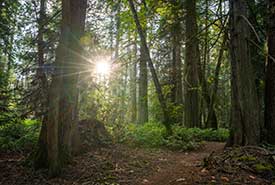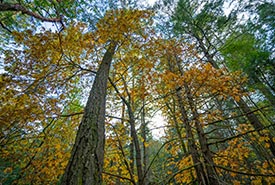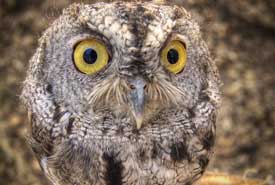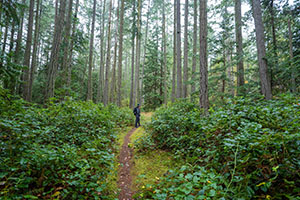Reginald Hill Conservation Area

Reginald Hill, Salt Spring Island, BC (Photo by Fernando Lessa)
Walking through the forest on Salt Spring Island’s Reginald Hill, it’s easy to imagine what the entirety of island once looked like. Douglas-fir, arbutus and Garry oaks tower overhead, dappled light making its way through the leaves to illuminate the forest floor. Rocky bluffs protrude from the moss and vegetation here and there throughout the sprawling landscape. Plants unfurl their leaves and creep along every available surface, while insects and animals crawl, scamper and fly through the lush woodlands.
This stunning, vital 161-hectare woodland forest will remain undisturbed and undeveloped, thanks to the support of many generous donors who supported the Nature Conservancy of Canada (NCC) in acquiring the land for conservation.
Reginald Hill, located on the southern side of the island overlooking Fulford Harbour, supports some of British Columbia’s most rare and imperilled ecosystems: those associated with the Coastal Douglas-fir biogeoclimatic zone. This is the most at-risk ecological landscape in BC, making up only 0.3 per cent of the province’s land base, and the forests found within it are essential to the survival of some of BC’s most at-risk species. Conserving 161 hectares of Reginald Hill is a big move to help protect the endangered, plants, wildlife and unique ecological communities found within the Garry oak woodlands, Douglas-fir dominated forests and ephemeral wetlands on site.
Salt Spring Island is located in Coast Salish territory, and NCC’s Reginald Hill conservation area shares a border with Tsawout Reserve lands. NCC will take time to understand the land’s Indigenous cultural values so that key cultural priorities can be prioritized alongside ecological values as we develop a management plan for the conservation area.
Small island, big opportunity
One of the most significant elements of the Reginald Hill project is its size.
A large portion of the Coastal Douglas-fir forests on Salt Spring Island have been logged and converted for agricultural or residential use. Less than a quarter of the landscape on the island is currently protected. Reginald Hill itself is regenerating from a history of selective logging in the 1940s and a small amount of eco-forestry in the 1990s. Its location and size have also made it a prime candidate for subdivision and development. But thanks to the conservation-minded Beach family who owned the land for decades, the vital landscape will instead be protected by NCC for generations to come.

Reginald Hill forest in fall (Photo by Fernando Lessa)
“I am thrilled that the Nature Conservancy of Canada is providing protection for this super special land in perpetuity,” said Nancy Beach, one of the siblings who worked with NCC to conserve Reginald Hill. “The peaceful walk up the hill to the awe-inspiring hilltop view is undeniably enriching, and it was our parents’ dream to have the nature of this land preserved forever.”
Salt Spring Island residents were also instrumental in the success of this project, bringing forward local and ecological knowledge, donations and enthusiasm.
“Islanders have been very enthusiastic about conserving the property,” said local ecologist and conservation biologist Susan Hannon. “This is a special piece of land — it will be a jewel in the crown of protected areas on Salt Spring. It is large and relatively undisturbed, embedded in a landscape of other protected lands. For me, the highlights are the Garry oak ecosystems and the many small wetlands, providing habitat for several species at risk.”
Life in the forest

Western screech owl (Photo by Josh Shaw)
Despite past logging, Reginald Hill remains a thriving example of the Coastal Douglas-fir ecosystem. More than 40 per cent of the trees in the conservation area are estimated to be mature at 81 years old or older. Conserving the forest will allow the trees to continue to mature and develop characteristics of an old-growth forest over the coming centuries.
The dry, Mediterranean-like climate of the Coastal Douglas-fir zone are known for supporting a high biodiversity of species, many of which are at risk in BC. At-risk species have been observed in the area, including several that are listed on the federal Species at Risk Act, such as the common nighthawk (threatened), sharp-tailed snake (threatened) and a lichen known as peacock vinyl (special concern). Conserving this habitat and natural land cover will also help to hold and filter fresh water as it flows through the land: a vital function in this relatively developed landscape.
Reginald Hill Conservation Area is also embedded in a larger landscape of undeveloped and protected land. It is bordered by the Tsawout First Nation’s reserve lands, a regional park and lands protected by conservation covenants. It is also located near two provincial parks and two conservation areas already held by NCC, the Raymond M. Goodall Conservation Area and Ruby Alton Nature Sanctuary. This effectively extends the area of protection and creates a greater connected area for wildlife to thrive and move freely.
Results you can walk on

A trail that leads through Reginald Hill on Salt Spring Island. (Photo by Fernando Lessa)
The trails on Reginald Hill have long been enjoyed by the local community and will continue to be open for walk-in access only.
Due to the sensitive ecology of the site, dogs are not permitted within the conservation area. Mountain biking, motorized vehicles, camping, fires and horseback riding is also prohibited. You can view a map of publicly accessible trails here.
Thank you for treading lightly on the land and helping us care for this important area.
Partners in conservation
This project was made possible by funding from the Government of Canada, through the Canada Nature Fund. Additional funding was provided by the Gerald A. Cooper-Key Foundation and the generous contributions of more than 140 individual, corporate and foundation donors.




